Sleeping Beauty
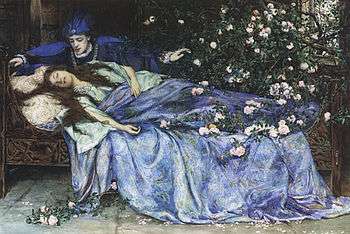
Sleeping Beauty (French: La Belle au bois dormant), or Little Briar Rose (German: Dornröschen), also titled in English as The Sleeping Beauty in the Woods, is a classic fairy tale which involves a beautiful princess, a sleeping enchantment, and a handsome prince. The tale was originally published by Charles Perrault. The version collected by the Brothers Grimm was an orally transmitted version of the original literary tale published by Perrault in Histoires ou contes du temps passé in 1697.[1] This in turn was based on Sun, Moon, and Talia by Italian poet Giambattista Basile (published posthumously in 1634), which was in turn based on one or more folk tales. The earliest known version of the story is found in the narrative Perceforest, composed between 1330 and 1344.
Perrault's narrative
Perrault’s narrative is written in two parts, which some folklorists believe were originally separate tales, as they were in the Brothers Grimm's version, and were later joined together by Giambattista Basile and once more by Perrault.[2]
Part one
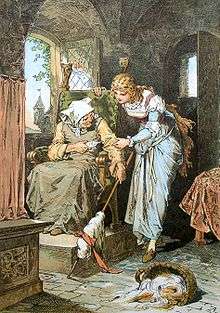
At the christening of a king and queen's long-wished-for child, seven good fairies are invited to be godmothers to the infant princess. The fairies attend the banquet at the palace. Each fairy is presented with a golden plate and drinking cups adorned with jewels. Soon after, an old fairy enters the palace and is seated with a plate of fine china and a crystal drinking glass. This old fairy is overlooked because she has been within a tower for many years and everyone had believed her to be deceased. Six of the other seven fairies then offer their gifts of beauty, wit, grace, dance, song, and goodness to the infant princess. The evil fairy is very angry about having been forgotten, and as her gift, enchants the infant princess so that she will one day prick her finger on a spindle of a spinning wheel and die. The seventh fairy, who hasn't yet given her gift, attempts to reverse the evil fairy's curse. However, she can only do so partially. Instead of dying, the Princess will fall into a deep sleep for 100 years and be awakened by a kiss from a king's son. This is her gift of protection.
The King orders that every spindle and spinning wheel in the kingdom to be destroyed, to try to save his daughter from the terrible curse. Fifteen or sixteen years pass and one day, when the king and queen are away, the Princess wanders through the palace rooms and comes upon an old woman, spinning with her spindle. The princess, who has never seen anyone spin before, asks the old woman if she can try the spinning wheel. The curse is fulfilled as the princess pricks her finger on the spindle and instantly falls into a deep sleep. The old woman cries for help and attempts are made to revive the princess. The king attributes this to fate and has the Princess carried to the finest room in the palace and placed upon a bed of gold and silver embroidered fabric. The king and queen kiss their daughter goodbye and depart, proclaiming the entrance to be forbidden. The good fairy who altered the evil prophecy is summoned. Having great powers of foresight, the fairy sees that the Princess will awaken to distress when she finds herself alone, so the fairy puts everyone in the castle to sleep. The fairy also summons a forest of trees, brambles and thorns that spring up around the castle, shielding it from the outside world and preventing anyone from disturbing the Princess.
A hundred years pass and a prince from another family spies the hidden castle during a hunting expedition. His attendants tell him differing stories regarding the castle until an old man recounts his father's words: within the castle lies a beautiful princess who is doomed to sleep for a hundred years until a king's son comes and awakens her. The prince then braves the tall trees, brambles and thorns which part at his approach, and enters the castle. He passes the sleeping castle folk and comes across the chamber where the Princess lies asleep on the bed. Struck by the radiant beauty before him, he falls on his knees before her. The enchantment comes to an end by a kiss and the princess awakens and converses with the prince for a long time. Meanwhile, the rest of the castle awakens and go about their business. The prince and princess are later married by the chaplain in the castle chapel.
Part two
After wedding the Princess in secret, the Prince continues to visit her and she bears him two children, Aurore (Dawn) and Jour (Day), unbeknown to his mother, who is of an ogre lineage. When the time comes for the Prince to ascend the throne, he brings his wife, children, and the talabutte ("Count of the Mount").
The Ogress Queen Mother sends the young Queen and the children to a house secluded in the woods and directs her cook to prepare the boy with Sauce Robert for dinner. The kind-hearted cook substitutes a lamb for the boy, which satisfies the Queen Mother. She then demands the girl but the cook this time substitutes a young goat, which also satisfies the Queen Mother. When the Ogress demands that he serve up the young Queen, the latter offers to slit her throat so that she may join the children that she imagines are dead. While the Queen Mother is satisfied with a hind prepared with Sauce Robert in place of the young Queen, there is a tearful secret reunion of the Queen and her children. However, the Queen Mother soon discovers the cook’s trick and she prepares a tub in the courtyard filled with vipers and other noxious creatures. The King returns in the nick of time and the Ogress, her true nature having been exposed, throws herself into the tub and is fully consumed. The King, young Queen, and children then live happily ever after.
Basile's narrative
In Giambattista Basile's version of Sleeping Beauty, Sun, Moon, and Talia, the sleeping beauty is named Talia. By asking wise men and astrologers to predict her future after her birth, her father who is a great lord learns that Talia will be in danger from a splinter of flax. The splinter later causes what appears to be Talia's death; however, it is later learned that it is a long, deep sleep. After Talia falls into deep sleep, she is seated on a velvet throne and her father, to forget his misery of what he thinks is her death, closes the doors and abandons the house forever. One day, while a king is walking by, one of his falcons flies into the house. The king knocks, hoping to be let in by someone, but no one answers and he decides to climb in with a ladder. He finds Talia alive but unconscious, and "...gathers the first fruits of love." [3] Afterwards, he leaves her in the bed and goes back to his kingdom. Though Talia is unconscious, she gives birth to twins — one of whom keeps sucking her fingers. Talia awakens because the twin has sucked out the flax that was stuck deep in Talia's finger. When she wakes up, she discovers that she is a mother and has no idea what happened to her. One day, the king decides he wants to go see Talia again. He goes back to the palace to find her awake and a mother to his twins. He informs her of who he is, what has happened, and they end up bonding. After a few days, the king has to leave to go back to his realm, but promises Talia that he will return to take her to his kingdom.
When he arrives back in his kingdom, his wife hears him saying "Talia, Sun, and Moon" in his sleep. She bribes and threatens the king's secretary to tell her what is going on. After the queen learns the truth, she pretends she is the king and writes to Talia asking her to send the twins because he wants to see them. Talia sends her twins to the "king" and the queen tells the cook to kill the twins and make dishes out of them. She wants to feed the king his children; instead, the cook takes the twins to his wife and hides them. He then cooks two lambs and serves them as if they were the twins. Every time the king mentions how good the food is, the queen replies, "Eat, eat, you are eating of your own." Later, the queen invites Talia to the kingdom and is going to burn her alive, but the king appears and finds out what’s going on with his children and Talia. He then orders that his wife be burned along with those who betrayed him. Since the cook actually did not obey the queen, the king thanks the cook for saving his children by giving him rewards. The story ends with the king marrying Talia and living happily ever after.[4]
Sources
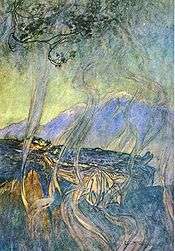
There are earlier elements that contributed to the tale. In the medieval courtly romance Perceforest (published in 1528), a princess named Zellandine falls in love with a man named Troylus. Her father sends him to perform tasks to prove himself worthy of her, and while he is gone, Zellandine falls into an enchanted sleep. Troylus finds her and impregnates her in her sleep; when their child is born, he draws from her finger the flax that caused her sleep. She realizes from the ring he left her that the father was Troylus, who later returns to marry her.[5]
Earlier influences come from the story of the sleeping Brynhild in the Volsunga saga and the tribulations of saintly female martyrs in early Christian hagiography conventions. It was, in fact, the existence of Brynhild that persuaded the Brothers Grimm to include the story in later editions of their work rather than eliminate it, as they did to other works they deemed to be purely French, stemming from Perrault's work. Their decision was odd on one point, at least, since in none of the Teutonic myths, meaning the Poetic and Prose Eddas or Volsunga Saga, is their sleeper awakened with a kiss, a fact Jacob Grimm would certainly have known, who wrote an important and encyclopedic volume on German Mythology.
The second half, in which the princess and her children are almost put to death, but instead hidden, may have been influenced by Genevieve of Brabant.[6]
Variants
The princess's name has varied from one adaptation to the other. In Sun, Moon, and Talia, she is named Talia (Sun and Moon being her twin children). She has no name in Perrault's story but her daughter is called "Aurore". The Brothers Grimm named her "Briar Rose" in their 1812 collection.[7] Tchaikovsky's ballet and Disney's version named her Princess Aurora; however, in the Disney version, she is also called "Briar Rose" in her childhood, when she is being raised incognito by the good fairies.[8] John Stejean named her "Rosebud" in TeleStory Presents.
The Brothers Grimm included a variant Little Briar Rose in their collection (1812).[7] Their version ends when the prince arrives to wake Sleeping Beauty, unlike the stories of Basile and Perrault.[9] Some translations of the Grimms' tale give the princess the name "Rosamond". The brothers considered rejecting the story on the grounds that it was derived from Perrault's version, but the presence of the Brynhild tale convinced them to include it as an authentically German tale. Still, it is the only known German variant of the tale, and Perrault's influence is almost certain.[10]
The Brothers Grimm also included, in the first edition of their tales, a fragmentary fairy tale, "The Evil Mother-in law". This story begins with the heroine a married mother of two children, as in the second part of Perrault's tale, and her mother-in-law attempting to eat her and the children. Unlike Perrault's version, the heroine suggested an animal be substituted in the dish, and ends with the heroine's worry that she cannot keep her children from crying and getting the mother-in-law’s attention. Like many German tales showing French influence, it appeared in no subsequent edition.[11]
Italo Calvino included a variant in Italian Folktales. The cause of her sleep is an ill-advised wish by her mother. As in Pentamerone, the prince rapes her in her sleep and her children are born. He retains the element that the woman who tries to kill the children is the king's mother, not his wife, but adds that she does not want to eat them herself, but instead serves them to the king. His version came from Calabria, but he noted that all Italian versions closely followed Basile's.[12][13]
Besides Sun, Moon, and Talia, Basile included another variant of this Aarne-Thompson type, The Young Slave. The Grimms also included a second, more distantly related one, The Glass Coffin.[14]
Joseph Jacobs noted that the figure of the Sleeping Beauty was in common between this tale and the Gypsy tale The King of England and his Three Sons, in his More English Fairy Tales.[15]
The hostility of the king's mother to his new bride is repeated in the fairy tale The Six Swans,[16] and also features The Twelve Wild Ducks, where she is modified to be the king's stepmother. However, these tales omit the attempted cannibalism.
Myth themes
Some folklorists have analyzed Sleeping Beauty as indicating the replacement of the lunar year (with its thirteen months, symbolically depicted by the thirteen fairies) by the solar year (which has twelve, symbolically the invited fairies). The basic elements of the story can also be interpreted as a nature allegory: the princess represents nature, the wicked fairy godmother is winter, who puts the Court to sleep with pricks of frost until the prince (spring) cuts away the brambles with his sword (a sunbeam) to allow the Sun to awaken sleeping princess (nature).
Media
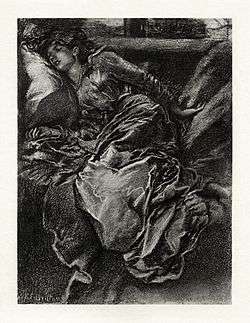

- Sleeping Beauty has been popular for many fairytale fantasy retellings. These include Alex Flinn's "A Kiss In Time", Robin McKinley's Spindle's End, Orson Scott Card's Enchantment, Neil Gaiman's The Sleeper and the Spindle, Jane Yolen's Briar Rose, Sophie Masson's Clementine, and Anne Rice's (as A. N. Roquelaure) erotic series The Sleeping Beauty Quartet.
In film and television
- The Sleeping Princess (1939), a Walter Lantz Productions animated short parodying the original fairy tale.
- Sleeping Beauty (1959), a Walt Disney animated film based on both Charles Perrault and the Brother's Grimm's versions.
- Maleficent (2014), a Walt Disney live-action adaptation starring Angelina Jolie as Maleficent and Elle Fanning as Princess Aurora, the Sleeping Beauty.
- La belle endormie (The Sleeping Beauty) (2010), a film by Catherine Breillat.
- Sleeping Beauty (2011), directed by Julia Leigh and starring Emily Browning, about a young girl who takes a sleeping potion and lets men have their way with her to earn extra money.
- Sleeping Beauty (1987), a direct-to-television musical film directed by David Irving.
- Bellas durmientes (Sleeping Beauties) (2001), directed by Eloy Lozano, adapted from the Kawabata novel.
- The Curse of Sleeping Beauty (2016), an American horror film directed by Pearry Reginald Teo.
- Some Call It Loving (also known as Sleeping Beauty) (1973), directed by James B. Harris and starring Zalman King, Carol White, Tisa Farrow, and Richard Pryor, based on a short story by John Collier.
- Prinsessa Ruusunen (1949), a Finnish film directed by Edvin Laine and scored with Erkki Melartin's incidental music from 1912.
- Dornröschen (1955), a German film directed by Fritz Genschow.
- Once Upon a Time (2011), an ABC TV show starring Sarah Bolger and Julian Morris.
- Ever After High, episode Briar Beauty (2015), an animated Netflix series.
- Archie Campbell satirized the story with "Beeping Sleauty" in several Hee Haw television episodes.
In literature
- Sleeping Beauty (1830), and The Day-Dream (1842), two poems based on Sleeping Beauty by Alfred, Lord Tennyson.[17]
- The Rose and the Ring (1854), a satirical fantasy by William Makepeace Thackeray.
- The Sleeping Beauty (1919), a poem by Mary Carolyn Davies'[18] about a failed hero who did not waken the princess, but died in the enchanted briars surrounding her palace.
- The Sleeping Beauty (1920), a retelling of the fairy tale by Charles Evans, with illustrations by Arthur Rackham.
- Briar Rose (Sleeping Beauty) (1971), a poem by Anne Sexton in her collection Transformations (1971), in which she re-envisions sixteen of the Grimm's Fairy Tales.[19]
- The Sleeping Beauty Quartet (1983-2015), four erotic novels written by Anne Rice under the pen name A.N. Roquelaure, set in a medieval fantasy world and loosely based on the fairy tale.
- Beauty (1992), a novel by Sheri S. Tepper.
- The Gates of Sleep (2012), a novel by Mercedes Lackey from the Elemental Masters series set in Edwardian England.
- Enchantment (1999), a novel by Orson Scott Card based on the Russian version of Sleeping Beauty.
In music
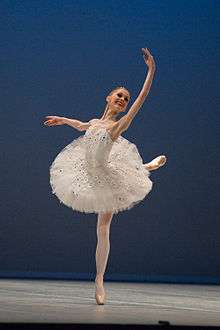
- La Belle au Bois Dormant (1825), an opera by Michele Carafa.
- La belle au bois dormant (1829), a ballet in four acts with book by Eugène Scribe, composed by Ferdinand Hérold and choreographed by Jean-Louis Aumer.
- The Sleeping Beauty (1890), a ballet by Tchaikovsky.
- Dornröschen (1902), an opera by Engelbert Humperdinck.
- Pavane de la Belle au bois dormant (1910), the first movement of Ravel's Ma mère l'Oye.[20]
- Sleeping Beauty Wakes (2008), an album by the American musical trio GrooveLily.
- Sleeping Beauty: You Are the One You Have Been Waiting On (2010), an album by Abby Dobson loosely based on the fairy tale.
In video games
- Kingdom Hearts is a video game in which Maleficent is one of the main antagonists and Aurora is one of the Princesses of Heart, together with the other Disney princesses.
- Dark Parables, game one, Curse of Briar Rose is a computer game series where the player's mission is to find Briar and wake her up, thus ending the curse for good.
- Little Briar Rose is a point-and-click adventure inspired by the Brothers Grimm's version of the fairy tale.
In other
- In Tales from the Crypt (1954), the December/January issue featured a version of Sleeping Beauty with a macabre twist.
- Sleeping Beauty is mentioned in passing in a companion to The League of Extraordinary Gentlemen, The New Traveller's Almanac.
- In the Sailor Moon anime, Awaken, Sleeping Beauty! Mamoru's Distress, Sailor Moon is fighting two of the Ayakashi sisters from the Black moon when she is put into a deep sleep from which only Mamoru's kiss can wake her.
In art
 Sleeping Beauty, by Alexander Zick (1845–1907)
Sleeping Beauty, by Alexander Zick (1845–1907)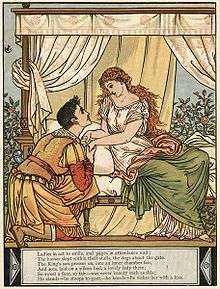 He stands—he stoops to gaze—he kneels—he wakes her with a kiss, woodcut by Walter Crane
He stands—he stoops to gaze—he kneels—he wakes her with a kiss, woodcut by Walter Crane Prince Florimund finds the "Sleeping Beauty"
Prince Florimund finds the "Sleeping Beauty" Sleeping Beauty by Jenny Harbour
Sleeping Beauty by Jenny Harbour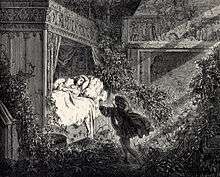 Perrault's La Belle au bois dormant (Sleeping Beauty), illustration by Gustave Doré
Perrault's La Belle au bois dormant (Sleeping Beauty), illustration by Gustave Doré Book cover for a Dutch interpretation of the story by Johann Georg van Caspel
Book cover for a Dutch interpretation of the story by Johann Georg van Caspel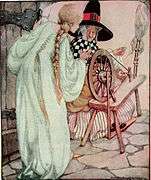 Briar Rose
Briar Rose Sleeping Beauty by Edward Frederick Brewtnall
Sleeping Beauty by Edward Frederick Brewtnall Louis Sußmann-Hellborn (1828- 1908) Sleeping Beauty,
Louis Sußmann-Hellborn (1828- 1908) Sleeping Beauty,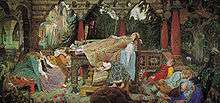 Sleeping Princess by Viktor Vasnetsov
Sleeping Princess by Viktor Vasnetsov The Sleeping Beauty by Sir Edward Burne-Jones
The Sleeping Beauty by Sir Edward Burne-Jones Sleeping Beauty, statue in Wuppertal – Germany
Sleeping Beauty, statue in Wuppertal – Germany
See also
References
- ↑ Bottigheimer, Ruth. (2008). "Before Contes du temps passe (1697): Charles Perrault's Griselidis, Souhaits and Peau". The Romantic Review, Volume 99, Number 3. pp. 175–189.
- ↑ Maria Tatar, The Annotated Classic Fairy Tales, 2002:96, ISBN 0-393-05163-3
- ↑ "Sleeping Beauty".
- ↑ Basile, Giambattista. "Sun, Moon, and Talia". Retrieved 31 March 2013.
- ↑ Jack Zipes, The Great Fairy Tale Tradition: From Straparola and Basile to the Brothers Grimm, p 648, ISBN 0-393-97636-X
- ↑ Charles Willing, "Genevieve of Brabant"
- 1 2 Jacob and Wilheim Grimm, Grimms' Fairy Tales, "Little Briar-Rose"
- ↑ Heidi Anne Heiner, "The Annotated Sleeping Beauty"
- ↑ Harry Velten, "The Influences of Charles Perrault's Contes de ma Mère L'oie on German Folklore", p 961, Jack Zipes, ed. The Great Fairy Tale Tradition: From Straparola and Basile to the Brothers Grimm, ISBN 0-393-97636-X
- ↑ Harry Velten, "The Influences of Charles Perrault's Contes de ma Mère L'oie on German Folklore", p 962, Jack Zipes, ed. The Great Fairy Tale Tradition: From Straparola and Basile to the Brothers Grimm, ISBN 0-393-97636-X
- ↑ Maria Tatar, The Annotated Brothers Grimm, p 376-7 W. W. Norton & company, London, New York, 2004 ISBN 0-393-05848-4
- ↑ Italo Calvino, Italian Folktales p 485 ISBN 0-15-645489-0
- ↑ Italo Calvino, Italian Folktales p 744 ISBN 0-15-645489-0
- ↑ Heidi Anne Heiner, "Tales Similar to Sleeping Beauty"
- ↑ Joseph Jacobs, More English Fairy Tales, "The King of England and his Three Sons"
- ↑ Maria Tatar, The Annotated Brothers Grimm, p 230 W. W. Norton & company, London, New York, 2004 ISBN 0-393-05848-4
- ↑ Hill, Robert (1971), Tennyson's Poetry p. 544. New York: Norton.
- ↑ Cook, Howard Willard Our Poets of Today, p. 271, at Google Books
- ↑ "Transformations by Anne Sexton"
- ↑ "Ravel : Ma Mère l'Oye". genedelisa.com.
External links
| Wikimedia Commons has media related to Sleeping Beauty. |
- Sleeping beauty in the woods, by Perrault, 1870 illustrated scanned book via Internet Archive
- The Stalk of Flax adapted by Amy Friedman and Meredith Johnson
